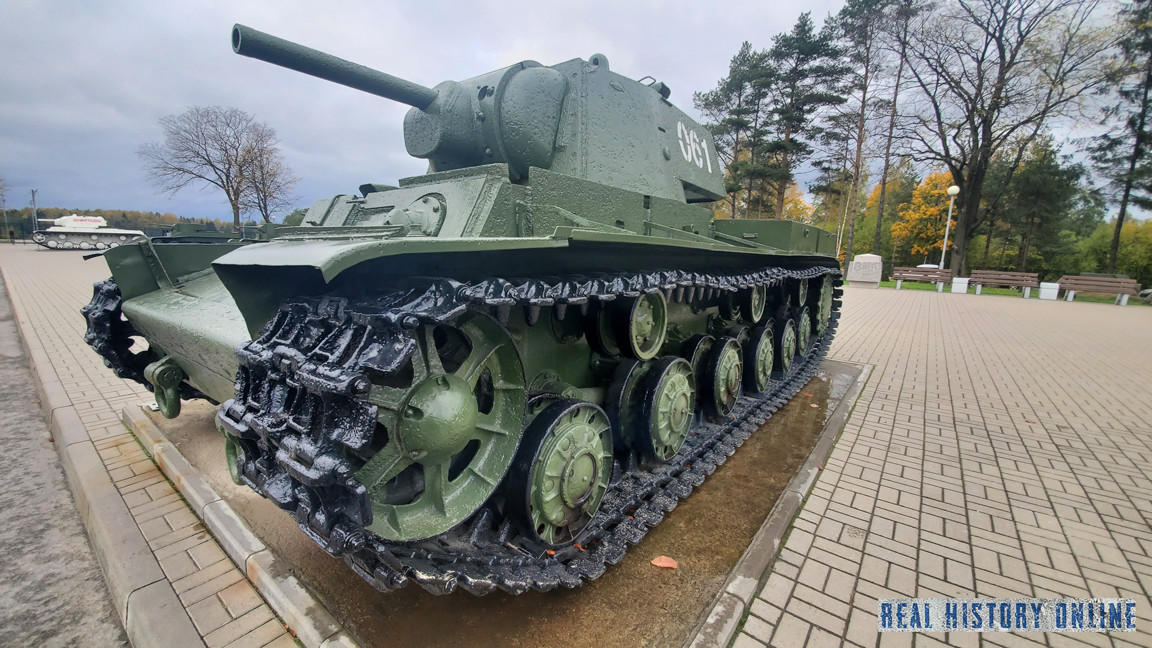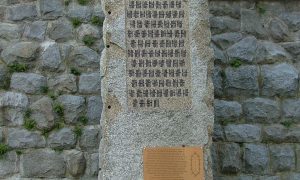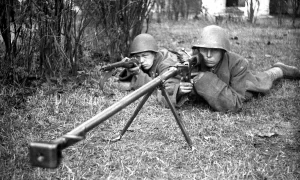KV-1 Heavy Soviet Tank – Shocking Surprise to The German and Axis Forces.
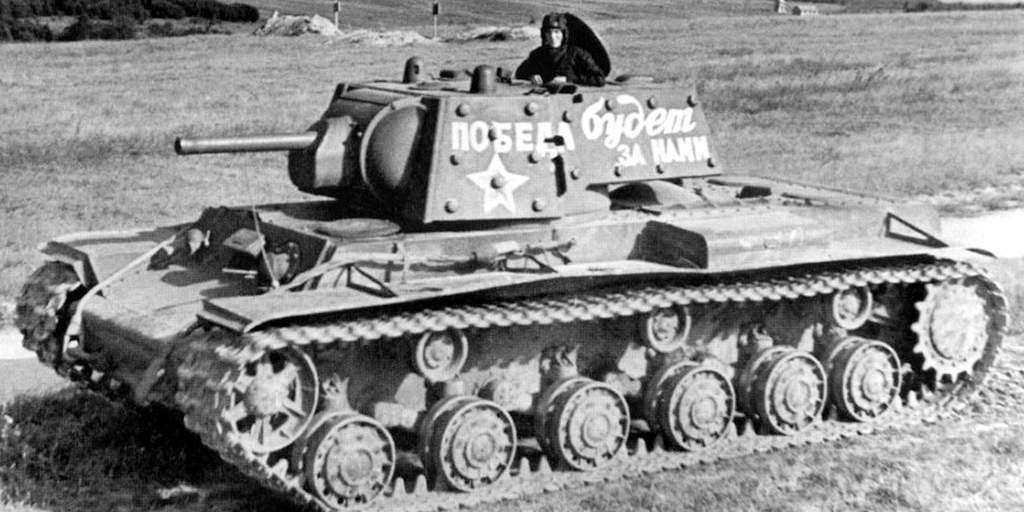
KV1 Early War
KV-1 (named after Kliment Voroshilov, like the rest of the tanks of the KV series) is a Soviet heavy tank of World War 2. Usually called simply “KV”: the tank was created under this name, and only later, after the appearance of the KV-2 tank, the KV of the first sample retrospectively received a digital index. Produced from August 1938 to August 1942.
The need to create a heavy tank carrying anti-cannon armor was well understood in the USSR. According to domestic military theory, such tanks were necessary to break open the enemy front and organize a breakthrough or overcome fortified areas. Most of the armies of the developed countries of the world had their own theories and practices of overcoming the powerful fortified positions of the enemy, experience in this was gained during the First World War. Such modern fortified lines as, for example, the Maginot Line or the Siegfried Line were considered even theoretically insurmountable.
History of KV1 Design
There was an erroneous opinion that the tank was created during the Finnish campaign to break through the Finnish long-term fortifications (Mannerheim Line). In fact, the design of the tank began as early as the end of 1938, when it became finally clear that the concept of a multi-turreted heavy tank like the T-35 was a dead end. It was obvious that the presence of a large number of towers, although an advantage in firepower, inevitably entails side effects in the form of a more complex design and, as a result, its higher cost, lower production speed and less reliability. And the gigantic dimensions of the tank only make it heavier and unmask it and did not allow the use of sufficiently thick armor. The initiator of the creation of the tank was the head of the ABTU of the Red Army commander D. G. Pavlov.
At the end of the 1930s, attempts were made to develop a tank of reduced (compared to the T-35) size, but with thicker armor. However, the designers did not dare to abandon the use of several towers: it was believed that one gun would fight infantry and suppress firing points, and the second must be anti-tank – to fight armored vehicles.
The new tanks created under this concept (SMK and T-100) were double-turreted, armed with 76 mm and 45 mm guns. And only as an experiment, they also developed a smaller version of the QMS – with one tower. Due to this, the length of the machine was reduced (by two road wheels), which had a positive effect on the dynamic characteristics. Unlike its predecessor, the KV (as the experimental tank was called) received a diesel engine. The first copy of the tank (U-0) was manufactured at the Leningrad Kirov Plant (LKZ) in August 1939. Initially, the leading designer of the tank was A. S. Ermolaev, then – N. L. Dukhov.
On November 30, 1939, the Soviet-Finnish war began. The military did not miss the opportunity to test new heavy tanks. The day before the start of the war (November 29, 1939), the SMK, T-100 and KV went to the front. They were handed over to the 20th heavy tank brigade, equipped with T-28 medium tanks.
The KV took the first battle on December 17 during the breakthrough of the Hottinensky fortified area of the Mannerheim line.
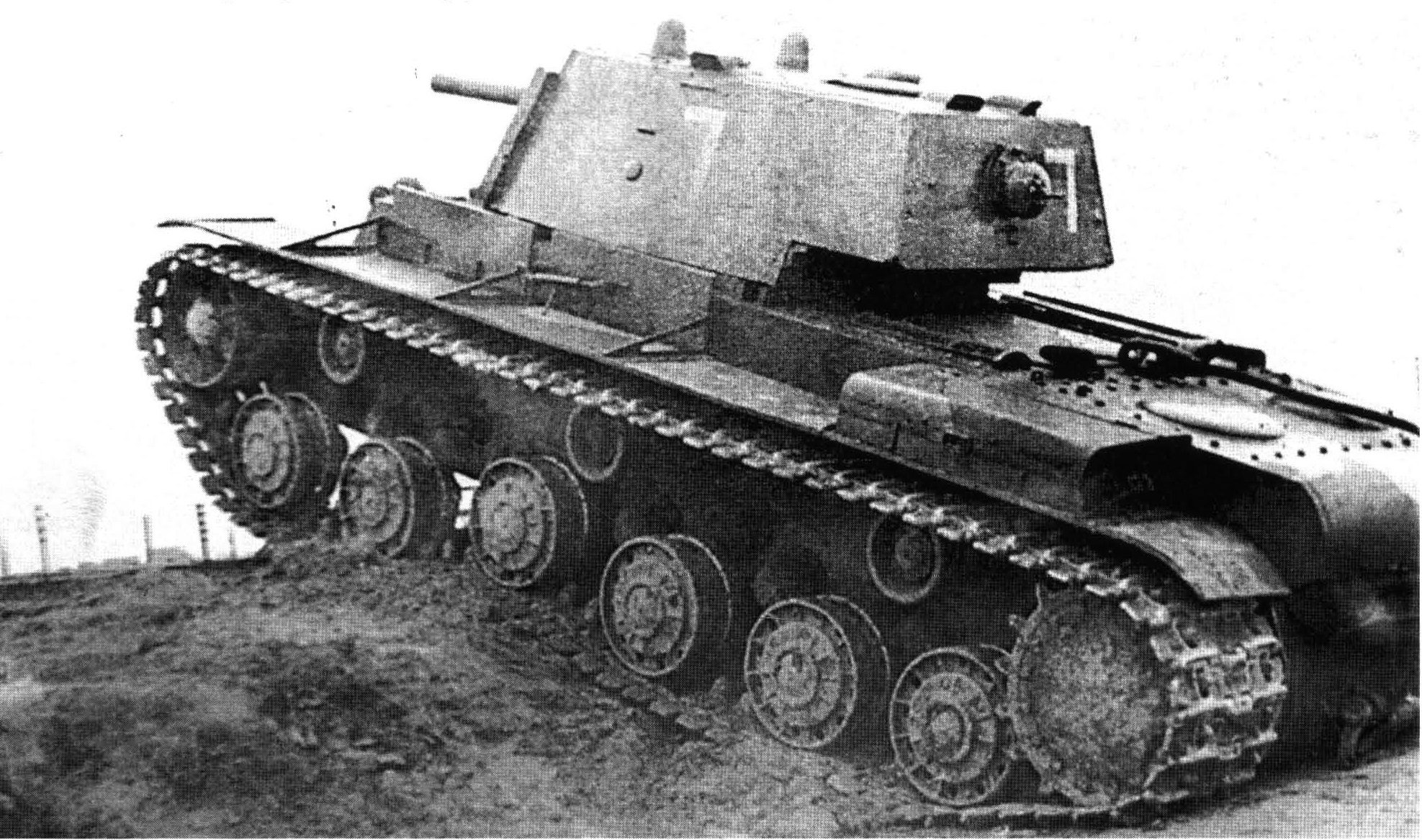
KV crew in the first battle:
- lieutenant Kachekhin (commander)
- military engineer of the 2nd rank (driver) I. Golovachev
- lieutenant Polyakov (gunner)
- K. Bucket (driver, tester of the Kirov plant)
- A. I. Estratov (mechanic / loader, tester of the Kirov Plant)
- P. I. Vasiliev (transmission operator / radio operator, tester at the Kirov Plant)
The tank successfully passed combat tests: not a single enemy anti-tank gun could destroy it. The military was upset only by the fact that the 76-mm L-11 gun was not strong enough to deal with pillboxes. For this purpose, a new KV-2 tank had to be created, armed with a 152-mm howitzer.
On the recommendation of the GABTU, by a joint resolution of the Politburo of the Central Committee of the All-Union Communist Party of Bolsheviks and the Council of People’s Commissars of the USSR of December 19, 1939 (already a day after the tests), the KV tank was put into service. As for the SMK and T-100 tanks, they also showed themselves in a rather favorable light (however, the SMK was blown up by a mine at the beginning of hostilities), but they were not accepted into service, because with higher firepower they carried thinner armor, had larger dimensions and weight, as well as worse dynamic characteristics.
Mass production
Serial production of KV tanks began in February 1940 at the Kirov Plant. In accordance with the decree of the Council of People’s Commissars of the USSR and the Central Committee of the All-Union Communist Party of Bolsheviks of June 19, 1940, the Chelyabinsk Tractor Plant (ChTZ) was also instructed to start producing KV. On December 31, 1940, the first KV was assembled at ChTZ. At the same time, the construction of a special building for the assembly of HF began at the plant.
In 1941, it was planned to produce 1200 KV tanks of all modifications. Of these, at the Kirov Plant – 1000 pcs. (400 KV-1, 100 KV-2, 500 KV-3) and another 200 KV-1 at ChTZ. However, only 25 tanks were handed over to ChTZ by the middle of the year. In total, 139 KV-1 and 104 KV-2 were built in 1940, and 393 (including 100 KV-2) in the first half of 1941.
| Production of KV-1 (according to the Military Acceptance) | |||||||||||||||
| Year/month | Manufacturer | Armament | 1 | 2 | 3 | 4 | 5 | 6 | 7 | 8 | 9 | 10 | 11 | 12 | Total |
| 1939 | LKZ | L-11 | 1 | 1 | |||||||||||
| 1940 | LKZ | L-11 | 5 | 1 | 7 | 5 | 10 | 32 | 52 | 12 | 15 | 139 | |||
| 1941 | LKZ | L-11 | 1 | 1 | |||||||||||
| F-32 | 45 | 44 | 62 | 66 | 10 | 40 | 153 | 180 | 81 * | 30 ** | 711 | ||||
| ChTZ (ChKZ) | L-11 | 1 | 2 | 3 | |||||||||||
| F-32 | 1 | 4 | 6 | 11 | 24 | 27 | 8 | 81 | |||||||
| ZiS-5 | 19 *** | 62 | 156 | 190 | 427 | ||||||||||
| Total for 1941 | 47 | 46 | 63 | 70 | 16 | 51 | 177 | 207 | 108 | 92 | 156 | 190 | 1223 | ||
| 1942 | CHKZ | ZiS-5 | 216 | 262 | 250 | 260 | 325 | 287 | 130 | 70 | 1800 | ||||
| 20K, ATO-41/42 (KV-8) | 2 | 22 | 26 | 13 | 18 | 21 | 102 | ||||||||
| Total for 1942 | 216 | 264 | 250 | 282 | 351 | 300 | 148 | 91 | 1902 | ||||||
| Total | 3265 | ||||||||||||||
* Including 3 tanks were equipped with a flamethrower instead of a course machine gun
** In addition, three experimental KVs were transferred to the Military Acceptance: 1 T-150 and 2 T-220.
*** “19 pieces without guns and 18 of them are at the factory waiting for their installation.” In fact, 17 of them were delivered in November, and one (No. 6740), in October, was sent for testing.
In total, 3163 KV-1 and 102 KV-8 were produced from 1939 to 1942.
In September 1941, the blockade of Leningrad began, but the production of KV-1 tanks in Leningrad did not end there. In the besieged city at plant number 371 in October-November 1941, 70 hulls and 130 towers were assembled from the unused backlog evacuated from the Izhora plant. This made it possible already in November to produce the first two tanks (No. C-001 and C-002). One of them (S-002) as of December 4 was already listed in the 86th separate tank battalion of the Leningrad Front. It was destroyed near the village of Krasny Bor on December 23, 1941.
In December-January, the plant did not work. In total, by the beginning of April 1942, the plant had repaired 53 KVs and reassembled 5 tanks (No. C-001 – C-005). In the 2nd quarter, 11 tanks were manufactured, in July – 6, in August – 5, in October – 8, in November – 12, in December – 2. A total of 49 KV-1. Also in 1942, 139 KV were repaired.
In 1943, another 21 cars were produced. Only the last 30 tanks were armed with the ZiS-5 gun; the first 40 received the F-32, and 29 of these guns were reassembled from backlogs with LKZ.
Thus, from November 1941 to 1943, 70 KV-1s (No. C-001 – C-070) were assembled from newly manufactured hulls and turrets and units, both left after the evacuation of the LKZ and the Izhora plant, and delivered from ChKZ. Since these machines were only for the needs of the Leningrad Front, cut off from the “mainland”, they were not included in the reports of the GABTU.
Despite the difficulties associated with the evacuation and deployment of the plant in a new location, in the second half of 1941, the front received 933 KV tanks. In 1942, 2553 of them were built (including KV-1s and KV-8). In August 1942, the KV-1 was taken out of production and replaced by a modernized version, the KV-1S. One of the reasons for the modernization was the heavy weight of the tank and the unreliability of its transmission. In total, the number of produced KVs with a 76-mm cannon can be estimated at 3233 tanks (excluding KV-2, KV-8, T-150 and T-220).
KV1 Tank Design
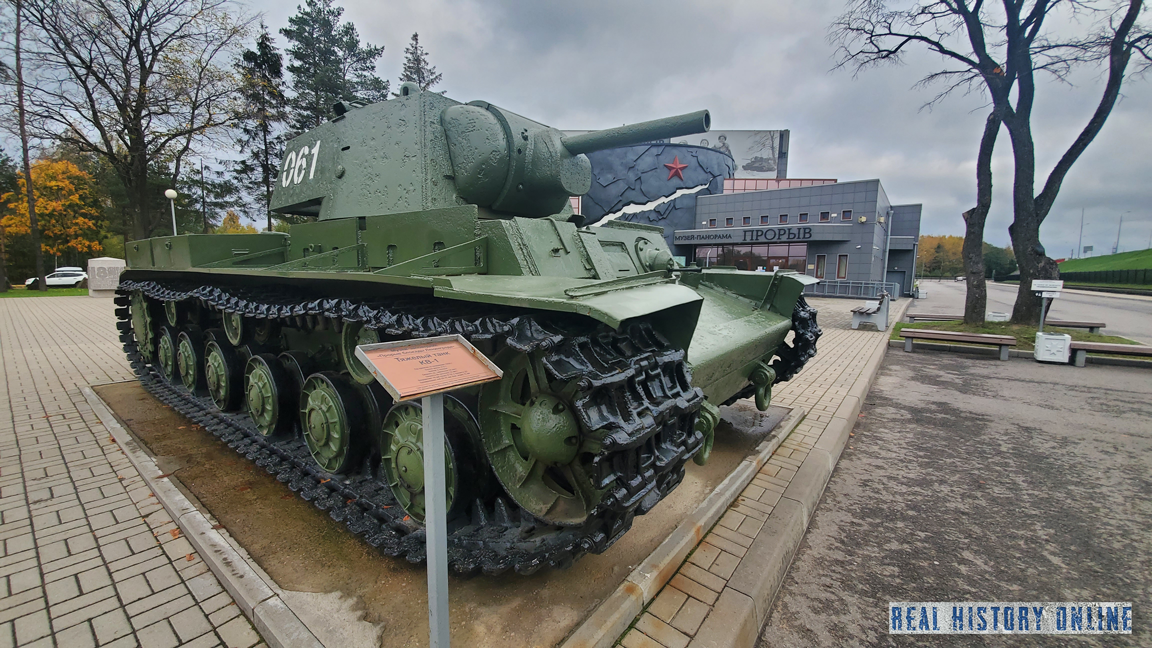 For 1940, the serial KV-1 was a truly innovative design that embodied the most advanced ideas of that time: an individual torsion bar suspension, reliable armor, a diesel engine and one powerful universal gun in a classic layout. Although individual solutions from this set were repeatedly implemented earlier on other foreign and domestic tanks, the KV-1 was the first combat vehicle to embody their combination. Some experts regard it as a milestone in world tank building, which had a significant impact on the development of subsequent heavy tanks in other countries. The classic layout on a serial Soviet heavy tank was used for the first time, which allowed the KV-1 to obtain the highest level of security and a large modernization potential within this concept compared to the previous serial model of the T-35 heavy tank and experimental SMK and T-100 (all – multi-tower type). The basis of the classic layout is the division of the armored hull from bow to stern sequentially into the control compartment, fighting compartment and engine-transmission compartment. The driver and gunner-radio operator were located in the control compartment, three other crew members had jobs in the fighting compartment, which combined the middle part of the armored hull and the turret. The gun, ammunition for it and part of the fuel tanks were also located there. The engine and transmission were installed in the rear of the tank.
For 1940, the serial KV-1 was a truly innovative design that embodied the most advanced ideas of that time: an individual torsion bar suspension, reliable armor, a diesel engine and one powerful universal gun in a classic layout. Although individual solutions from this set were repeatedly implemented earlier on other foreign and domestic tanks, the KV-1 was the first combat vehicle to embody their combination. Some experts regard it as a milestone in world tank building, which had a significant impact on the development of subsequent heavy tanks in other countries. The classic layout on a serial Soviet heavy tank was used for the first time, which allowed the KV-1 to obtain the highest level of security and a large modernization potential within this concept compared to the previous serial model of the T-35 heavy tank and experimental SMK and T-100 (all – multi-tower type). The basis of the classic layout is the division of the armored hull from bow to stern sequentially into the control compartment, fighting compartment and engine-transmission compartment. The driver and gunner-radio operator were located in the control compartment, three other crew members had jobs in the fighting compartment, which combined the middle part of the armored hull and the turret. The gun, ammunition for it and part of the fuel tanks were also located there. The engine and transmission were installed in the rear of the tank.
KV1 Technical Specifications
| KV-1 | |
| KV-1 arr. 1940 | |
| Classification | Heavy Tank |
| Combat weight, Tons | 43 (1939), 47.5 (1941) |
| Layout Diagram | Classical |
| Crew | 5 |
| Story | |
| Manufacturer | JSC “Kirovskiy Zavod” |
| Years of production | 1939 – 1942 |
| Years of operation | 1940 – 1945 |
| Number of issued, pcs. | 3233 |
| Main Operators | Soviet Union |
| Dimensions | |
| Case length, mm | 6675 |
| Width, mm | 3320 |
| Height, mm | 2710 |
| Clearance, mm | 450 |
| Booking | |
| Armor Type | homogeneous rolled steel of medium hardness grades 49C and 42C |
| Forehead of the hull (top), mm/deg. | 75 / 30° |
| Forehead of the hull (middle), mm/deg. | 60 / 70° |
| Forehead of the hull (bottom), mm/deg. | 75 / 25° |
| Hull board, mm/deg. | 75 / 0° |
| Hull feed (top), mm/deg. | 60 / 50° |
| Hull feed (bottom), mm/deg. | 75 / 0—90° |
| Bottom, mm | 30-40 |
| Hull roof, mm | 30-40 |
| Tower forehead, mm/deg. | 75 / 20° |
| Gun mantlet, mm /deg. | 90 |
| Turret board, mm/deg. | 75 / 15° |
| Tower feed, mm/deg. | 75 / 15° |
| Tower roof, mm/deg. | 40 |
| Armament | |
| Caliber and make of the gun | 76 mm L-11, F-32, F-34 U-11, ZIS-5 |
| Gun Type | Rifled |
| Barrel length, calibers | 41.6 (for ZIS-5) |
| Gun Ammunition | 90 or 114 (depending on modification) |
| Angles VN, deg. | −7…+25° |
| Firing range, km | 1.5 |
| Sights | telescopic TOD-6, periscopic PT-6 |
| Machine Guns | 3 × DT |
| Mobility | |
| Engine Type | V-shaped 12 -cylinder four- stroke liquid-cooled diesel |
| Engine power, | 500 |
| Highway speed, km/h | 34 |
| Cruising range on the highway, km | 150-225 |
| Power reserve over rough terrain, km | 90-180 |
| Specific power, l. s./t | 11.6 |
| Suspension Type | Torsion |
| Specific ground pressure, kg/cm² | 0.77 |
Armored Hull and Turret
The armored hull of the tank was welded from rolled armor plates of medium hardness with a thickness of 80, 40, 30 and 20 mm. Equal-strength armor protection (armor plates with a thickness other than 75 mm were used only for horizontal armor of the vehicle), anti-ballistic. The armor plates of the frontal part of the machine were installed at rational angles of inclination. The serial KV tower was produced in three versions: cast, welded with a rectangular niche and welded with a rounded niche. The armor thickness of the welded turrets was 75 mm, and that of the cast turrets was 95 mm, since the cast armor was less durable. In the second half of 1941, the welded turrets and side armor plates of some tanks were additionally reinforced – 25-mm armor screens were bolted to them, and there was an air gap between the main armor and the screen, that is, this version of the KV-1 received spaced armor. This was done to increase protection against German 88 mm “Flak 88” anti-aircraft guns. The Germans began to develop heavy tanks only in 1941 (a heavy tank was not used in the German theory of blitzkrieg), so for 1941 even the standard KV-1 armor, in principle, was redundant (KV armor was not affected by regular 37-mm and 50-mm Wehrmacht anti-tank guns, but could be pierced by 75-mm, 88-mm, 105-mm and 150-mm guns). Some sources erroneously indicate that the tanks were produced with rolled armor 100 mm thick or more – in fact, this figure corresponds to the sum of the thickness of the tank’s main armor and screens.
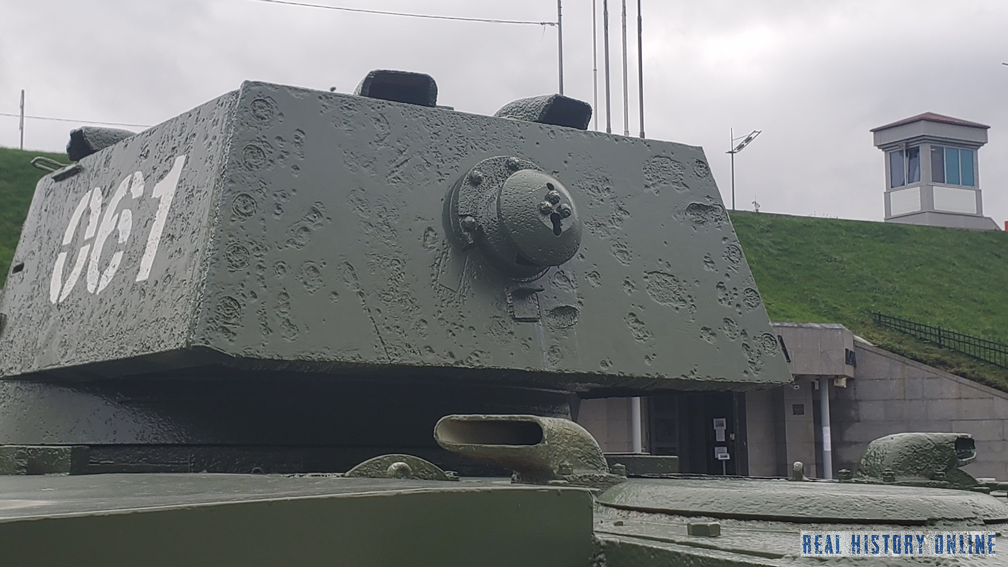 The decision to install “screens” was made at the end of June 1941, after the first reports of losses from German anti-aircraft guns, but already in August this program was curtailed, since the undercarriage could not withstand the mass of the vehicle, which increased to 50 tons. This problem was later partly overcome by the installation of heavy duty cast road wheels. Shielded tanks were used on the Northwestern and Leningrad fronts.
The decision to install “screens” was made at the end of June 1941, after the first reports of losses from German anti-aircraft guns, but already in August this program was curtailed, since the undercarriage could not withstand the mass of the vehicle, which increased to 50 tons. This problem was later partly overcome by the installation of heavy duty cast road wheels. Shielded tanks were used on the Northwestern and Leningrad fronts.
The frontal part of the turret with an embrasure for the gun, formed by the intersection of four spheres, was cast separately and welded with the rest of the turret armor. The gun mask was a cylindrical segment of bent rolled armor plates and had three holes – for a cannon, a coaxial machine gun and a sight. The tower was mounted on a shoulder strap with a diameter of 1535 mm in the armored roof of the fighting compartment and was fixed with grips to avoid stalling in case of a strong roll or overturning of the tank. Inside the turret shoulder strap was marked in thousandths for indirect fire.
The driver was located in the center in front of the armored hull of the tank, to the left of him was the workplace of the gunner-radio operator. Three crew members were located in the tower: to the left of the gun were the gunner and loader, and to the right – the tank commander. Entering and exiting of the crew were carried out through two round hatches: one in the tower above the commander’s position and one on the roof of the hull above the workplace of the gunner-radio operator. The hull also had a bottom hatch for emergency evacuation by the crew of the tank and a number of hatches, hatches and technological openings for loading ammunition, access to fuel tank fillers, other units and assemblies of the vehicle.
Armament
On the tanks of the first issues, the L-11 cannon of 76.2 mm caliber was installed with 111 rounds of ammunition (according to other sources – 135 or 116). It is interesting that the original project also provided for a 45 mm 20K cannon paired with it, although the armor penetration of the 76 mm L-11 tank gun was not inferior to the anti-tank 20K. There was still a persistent stereotype about the need to have a 45 mm gun as an anti-tank gun, and a 76 mm should have served as an assault gun. But, already on the prototype, aimed at the Karelian Isthmus, the 45-mm cannon was removed and the DT-29 machine gun was installed instead. Subsequently, the L-11 cannon was replaced with a 76-mm F-32 gun with similar ballistics, and in the fall of 1941 with a ZIS-5 gun with a longer barrel length of 41.6 calibers.
In September 1941, instead of a course machine gun, a flamethrower was installed on 3 tanks newly built at the LKZ, and one overhauled KV-1 underwent the same alteration.
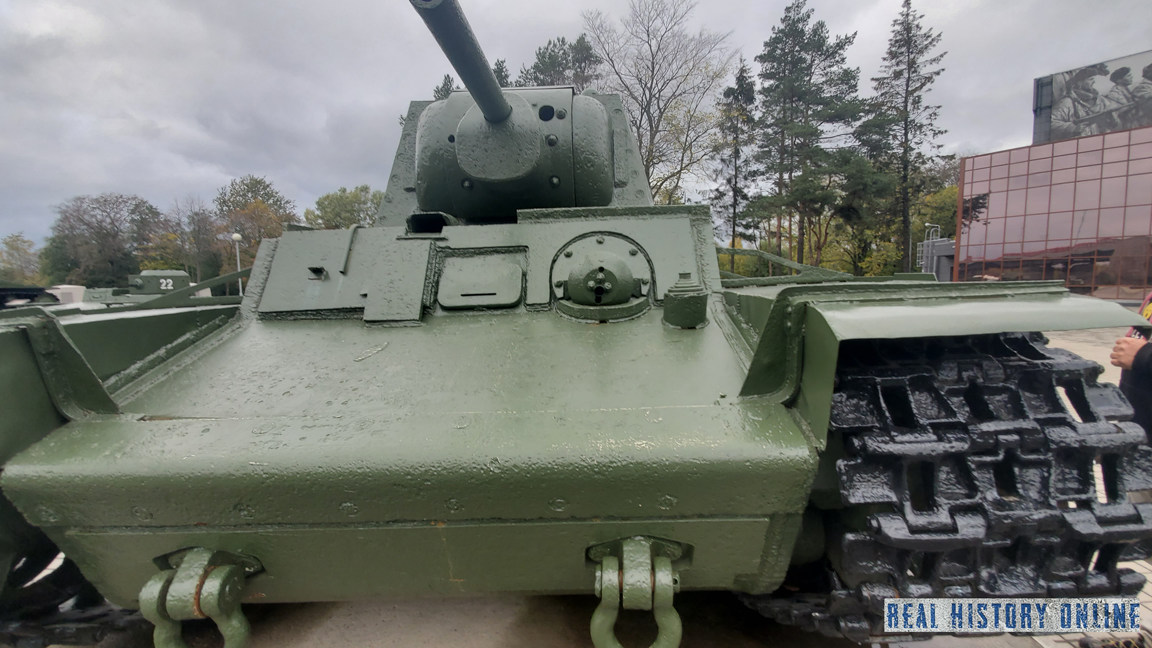 The ZIS-5 gun was mounted on trunnions in the turret and was fully balanced. The turret itself with the ZIS-5 gun was also balanced: its center of mass was located on the geometric axis of rotation. The ZIS-5 cannon had vertical aiming angles from −5 to +25°; with a fixed position of the turret, it could be aimed in a small sector of horizontal aiming (the so-called “jewelry” aiming). The shot was fired by means of a manual mechanical descent.
The ZIS-5 gun was mounted on trunnions in the turret and was fully balanced. The turret itself with the ZIS-5 gun was also balanced: its center of mass was located on the geometric axis of rotation. The ZIS-5 cannon had vertical aiming angles from −5 to +25°; with a fixed position of the turret, it could be aimed in a small sector of horizontal aiming (the so-called “jewelry” aiming). The shot was fired by means of a manual mechanical descent.
The ammunition load of the gun was 111-116 rounds of unitary loading, depending on the modification of the vehicle (10 in the aft niche of the tower, 78 in suitcases on the floor of the fighting compartment, 23-28 to the right of the driver at the side of the vehicle).
For the first 105 KV-1 tanks, including the U-0, the installation of a course machine gun was not provided: the radio operator was equipped with a port for firing from personal weapons. Starting from November 1940, three 7.62 mm DT-29 machine guns were already installed on the KV-1: coaxial with a gun, as well as course and stern in ball mounts. Ammunition was 2772 rounds. These machine guns were mounted in such a way that, if necessary, they could be removed from the mounts and used outside the tank. For self-defense, the crew had several F-1 hand grenades and was sometimes equipped with a pistol for firing flares. On every fifth KV, an anti-aircraft turret for machine gunsl was mounted, but anti-aircraft machine guns were rarely installed.
Engine
Initially, the tank was equipped with a V-2K 12-cylinder diesel engine with a working volume of 38.9 liters and a declared maximum power of 600 hp. With. at 1800 rpm. In November-December 1941, due to a shortage of V-2K diesel engines, which were then produced only at Kharkov Plant No. 75, which had been in the process of evacuation to the Urals since the fall of 1941, a 12-cylinder M-carburetor engine was forced to be installed on 130 tanks. 17T, with a working volume of 46.8 liters, a declared maximum power of 500 liters. With. at 1500 rpm. In the spring of 1942, after the evacuated plant had established sufficient production of diesel engines at the new location, a decision was issued to re-equip all KV-1 tanks with M-17T engines back to V-2K.
Starting the engine in both cases was provided by a ST-700 starter with a capacity of 15 liters. With. or compressed air from two tanks with a capacity of 5 liters in the fighting compartment of the vehicle. Due to the dense layout of the tank, the main fuel tanks with a volume of 600-615 liters were located both in the combat and in the engine compartment.
Transmission
The KV-1 tank was equipped with a mechanical transmission, which included:
- multi-disc main friction clutch of dry friction ” steel according to Ferodo “;
- five -speed tractor-type gearbox;
- two multi-plate side clutches with steel-on-steel friction;
- two onboard planetary gears;
- band floating brakes.
All transmission control drives are mechanical. During operation in the army, the greatest number of complaints and complaints against the manufacturer were caused precisely by defects and the extremely unreliable operation of the transmission group, especially for overloaded wartime KV tanks. Almost all authoritative printed sources recognize the low reliability of the transmission as a whole as one of the most significant shortcomings of the KV series tanks and vehicles based on it.
Chassis
Suspension of the machine – individual torsion bar with internal shock absorption for each of the 6 stamped dual-slope road wheels of small diameter on each side. Opposite each track roller, suspension balancers were welded to the armored hull. Drive wheels with removable lantern gears were located at the rear, and sloths at the front. The upper branch of the caterpillar was supported by three small rubber stamped support rollers on each side. In 1941, the technology for manufacturing track and support rollers was transferred to casting, the latter lost their rubber tires due to the general shortage of rubber at that time. Caterpillar tension mechanism – screw; each caterpillar consisted of 86-90 single-ridgetracks with a width of 700 mm and a pitch of 160 mm.
Electrical Equipment
The electrical wiring in the KV-1 tank was single-wire, the armored hull of the vehicle served as the second wire. The exception was the emergency lighting circuit, which was two-wire. The sources of electricity (operating voltage 24 V) were a GT-4563A generator with a RRA-24 relay-regulator with a power of 1 kW and four 6-STE-128 batteries connected in series with a total capacity of 128 Ah. Electricity consumers included:
- turret slewing electric motor;
- external and internal lighting of the machine, illumination devices for sights and scales of measuring instruments;
- external sound signal and alarm circuit from the landing party to the crew of the vehicle;
- instrumentation (ammeter and voltmeter);
- means of communication – a radio station and a tank intercom;
- electrician of the motor group – starter ST-700, starting relay RS-371 or RS-400, etc.
Means of Observation and Sights
The general visibility of the KV-1 tank back in 1940 was assessed in a memorandum to L. Mekhlis from military engineer Kalivoda as extremely unsatisfactory. The commander of the vehicle had a viewing device in the tower – a PTK panorama, which had a 2.5-fold increase and a field of view of 26 degrees, an onboard periscope and a viewing slot.
The driver in battle conducted observation through a viewing device with a triplex, which was protected by an armored shutter. This viewing device was installed in an armored plug hatch on the frontal armor plate along the longitudinal centerline of the vehicle, as well as a periscope. In a calm environment, this plug hatch could be pushed forward, providing the driver with a more convenient direct view from his workplace.
For firing, the KV-1 was equipped with two gun sights – a telescopic TOD-6 for direct fire and a periscope PT-6 for firing from closed positions. The head of the periscope sight was protected by a special armor cap. To ensure the possibility of fire in the dark, the scales of the sights had illumination devices. Forward and aft DT machine guns could be equipped with a PU sight from a sniper rifle with a threefold increase.
Means of Communication
The means of communication included the radio station 71-TK-3, later 10R or 10RK-26. On a number of tanks, 9R aviation radio stations were installed from a shortage. The KV-1 tank was equipped with an internal intercom TPU-4-Bis for 4 subscribers.
Radio stations 10R or 10RK were a set of transmitter, receiver and umformers (single-arm motor-generators) for their power supply, connected to the on-board electrical network with a voltage of 24 V.
10R was a simplex tube shortwave radio station operating in the frequency range from 3.75 to 6 MHz (respectively, wavelengths from 80 to 50 m). In the parking lot, the communication range in the telephone (voice) mode reached 20-25 km, while on the move it somewhat decreased. A longer communication range could be obtained in telegraph mode, when information was transmitted by telegraph key in Morse code or another discrete coding system. Frequency stabilization was carried out by a removable quartz resonator, there was no smooth frequency adjustment. 10P allowed communication on two fixed frequencies; to change them, another quartz resonator of 15 pairs was used in the radio set.
The 10RK radio station was a technological improvement of the previous 10R model, it became easier and cheaper to manufacture. This model has the ability to smoothly select the operating frequency, the number of quartz resonators has been reduced to 16. The characteristics of the communication range have not undergone significant changes.
The TPU-4-Bis tank intercom made it possible to negotiate between members of the tank crew even in a very noisy environment and connect a headset (head phones and throat phones) to a radio station for external communication.
Modifications of the KV tank
KV became the ancestor of a whole series of heavy tanks.
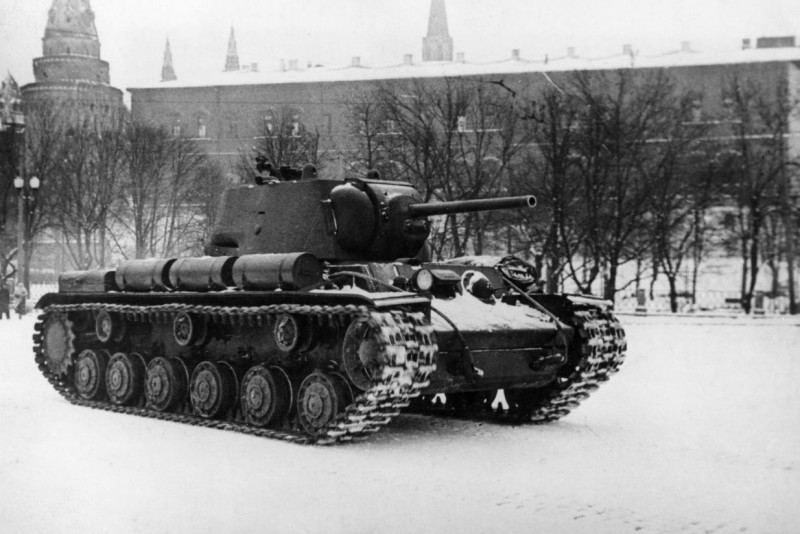
KV1S
The first “descendant” of the KV was the KV-2 tank, armed with a 152 mm M-10 howitzer mounted in a high turret. The KV-2 tanks were heavy self- propelled guns for their intended purpose, since they were intended to fight pillboxes, but the battles of 1941 showed that they are an excellent tool for fighting German tanks – shells of any German tank did not penetrate their frontal armor, but the KV-2 shell, as soon as he hit any German tank, he was almost guaranteed to destroy him. KV-2 fire could only be fired from a place. They began to be produced in 1940, and soon after the start of the Great Patriotic War, their production was curtailed.
In 1940, it was planned to put into production other tanks of the KV series. As an experiment, by the end of the year, one KV (T-150) with 90 mm armor (with a 76 mm F-32 gun) and two more (T-220) with 100 mm armor (one with a 76 mm F-32 gun) were made, the other with an 85 mm F-30 cannon). But things did not go beyond the manufacture of prototypes. All of them in October 1941 were equipped with standard KV-1 turrets with F-32 cannon and left for the front.
In September 1941, 4 KV-1 tanks (including one after repair) were equipped with a flamethrower. It was placed in the frontal part of the hull, in a small outbuilding, instead of a course machine gun. The rest of the weapons remained unchanged. This tank received the designation KV-6. In April 1942, the KV-8 flamethrower tank was created on the basis of the KV. The hull remained unchanged, a flamethrower (ATO-41 or ATO-42) was installed in the turret. Instead of a 76 mm gun, a 45 mm gun mod. 1934 with a camouflage casing that reproduces the external outlines of a 76 mm gun (a 76 mm gun, along with a flamethrower, did not fit in the turret).
In August 1942, it was decided to begin production of the KV-1s (“s” means “high-speed”). The leading designer of the new tank is N. F. Shashmurin.
The tank was lightened, among other things, by thinning the armor (for example, the thickness of the side and rear of the hull was reduced to 60 mm, the forehead of the cast turret was reduced to 82 mm). It still remained impenetrable to German guns, but the mass of the tank was reduced to 42.5 tons, and the speed and maneuverability increased significantly.
In 1941-1942, a missile modification of the tank was developed – KV-1K, equipped with the KARST-1 system (short tank artillery missile system).
The KV series also includes the KV-85 tank and the SU-152 (KV-14) self-propelled gun, however, they were created on the basis of the KV-1s and therefore are not considered here.
KV1 Combat Experience
Apart from, in fact, the experimental use of KV in the Finnish campaign, the tank went into battle for the first time after the German attack on the USSR. The very first meetings of German tankers with KV put them into a state of shock. The tank practically did not make its way from German tank guns (for example, a German sub-caliber projectile of a 50-mm tank gun pierced the vertical side of the KV from a distance of 300 m, and an inclined forehead only from a distance of 40m). Anti-tank artillery was also ineffective: for example, the armor-piercing projectile of the 50-mm Pak 38 anti-tank gun made it possible to hit KV in favorable conditions at a distance of only less than 500m. More effective was the fire of 105-mm howitzers and 88-mm anti-aircraft guns.
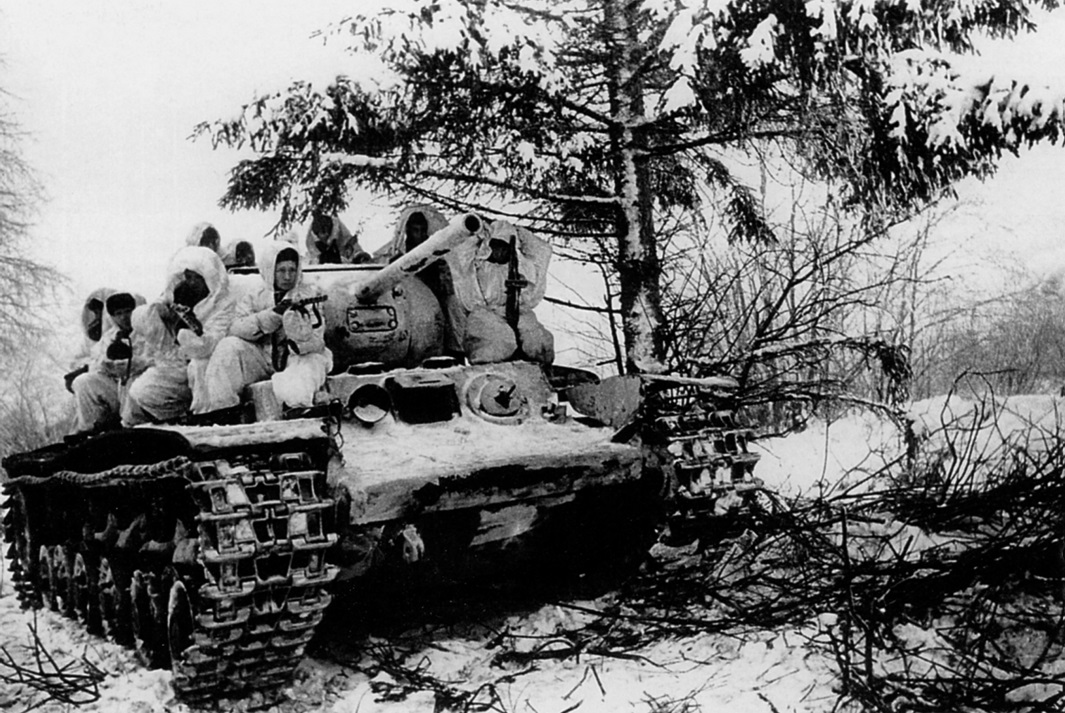
KV1 In the Snow
However, the tank was “raw”: the novelty of the design and the haste of introducing it into production affected. The transmission, which could not withstand the loads of a heavy tank, caused especially a lot of trouble – it often failed. And, if in open combat the KV really had no equal, then in the conditions of retreat, many KVs, even with minor breakdowns, had to be abandoned or destroyed. There was no way to repair or evacuate them.
Several KV – abandoned or knocked out – were restored by the Germans. However, captured HFs were used for a short time – the lack of spare parts affected them with the same frequent breakdowns.
HF caused conflicting assessments of the military. On the one hand – invulnerability, on the other – insufficient reliability. And with cross-country ability, not everything is so simple: the tank could hardly overcome steep slopes, many bridges could not withstand it. In addition, he destroyed any road – wheeled vehicles could no longer move behind him, which is why the KV was always placed at the end of the column. On the other hand, the tank showed itself excellently on the battlefield, when organizing tank ambushes and counterattacks by German mechanized columns.
In general, according to some contemporaries, the KV had no particular advantages over the T-34. The tanks were equal in firepower, both were less vulnerable to anti-tank artillery. At the same time, the T-34 had the best dynamic characteristics, was cheaper and easier to manufacture, which is important in wartime.
The disadvantages of the KV also include the unfortunate location of the hatches (for example, there is only one hatch in the tower, in case of fire it was very difficult for the three of us to quickly get out through it).
In order to eliminate numerous complaints in the summer of 1942, the tank was modernized. By reducing the thickness of the armor, the weight of the vehicle has decreased. Various major and minor flaws were eliminated, including “blindness” (a commander’s cupola was installed). The new version was named KV-1s.
The creation of the KV-1s was a justified step in the difficult first stage of the war. However, this move only brought the KV closer to medium tanks. The army never received a full-fledged (by later standards) heavy tank, which would differ sharply from the average in terms of combat power. Arming the tank with an 85-mm cannon could be such a step. But things did not go further than experiments, since ordinary 76-mm tank guns in 1941-1942 easily fought with any German armored vehicles, and there were no reasons to strengthen weapons.
However, after the appearance in the German army Pz. VI (“Tiger”) with an 88-mm cannon, all KVs became obsolete overnight: they were unable to fight German heavy tanks on equal terms. So, for example, on February 12, 1943, during one of the battles to break the blockade of Leningrad, three Tigers of the 1st company of the 502nd heavy tank battalion destroyed 10 KV. At the same time, the Germans had no losses – they could shoot KV from a safe distance. The situation in the summer of 1941 was exactly the opposite.
KV of all modifications were used until the very end of the war. But they were gradually replaced by more advanced heavy IS tanks. Ironically, the last operation in which KVs were used in large numbers was the breakthrough of the Karelian Wall in 1944. The commander of the Karelian Front, K. A. Meretskov, personally insisted that his front receive the KV (Meretskov commanded the army in the Winter War and then literally fell in love with this tank). The surviving KVs were collected literally one at a time and sent to Karelia – to the place where the career of this machine once began.
By that time, a small number of HFs were still in use. Basically, after the turret was dismantled, they served as evacuation vehicles in units equipped with new IS heavy tanks.
The last period of mass use of KV tanks was the Soviet-Japanese War of 1945. The Trans-Baikal Front included two regiments of KV tanks with 35 tanks each. Tanks were used in the assault on the city of Mudanjiang and the fortified area of the Kwantung Army of the same name.
Trophy in the German army
Captured KV-1s during the Great Patriotic War were used in the Nazi army under the designations:
- Panzerkampfwagen KV-IA 753(r) – KV-1,
- (Sturm)Panzerkampfwagen KV-II 754(r) – KV-2,
- Panzerkampfwagen KV-IB 755(r) – KV-1s.
- Panzerkampfwagen KV IC mit 7,5 cm KwK L/48 – KV-1s with KwK 40 cannon and MG-34 machine gun
Examples of combat use
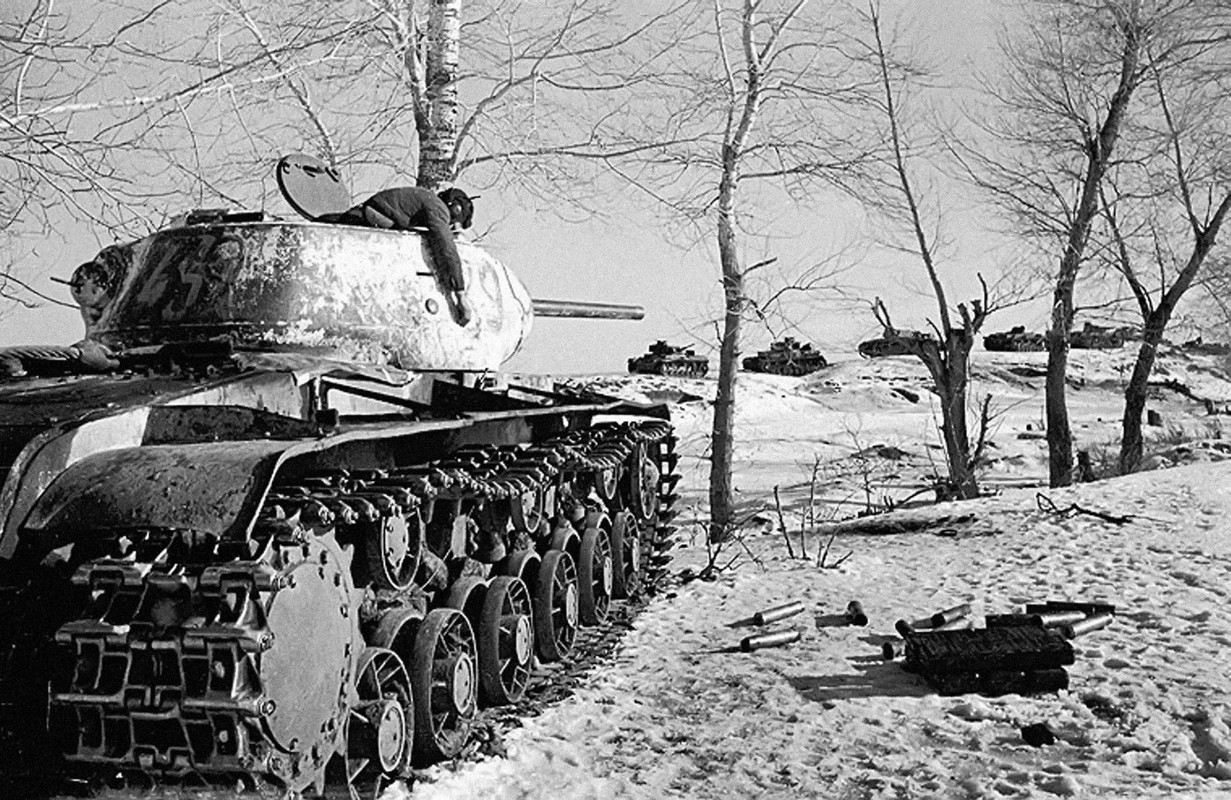
KV1-Destroying German Tank Column
- The crew of the KV-1 tank near the city of Raseiniai (in Lithuania) in June 1941 held back the Kampfgruppe (battle group) of the 6th Panzer Division of General F. Landgraf, equipped mainly with light Czech tanks Pz.35 (t) for a day during the day. This battle was described by the commander of the 6th motorized infantry brigade of the division E. Raus (commander of the Raus Kampfgruppe). One of the KV during the battle on June 24 turned left and took up a position on the road parallel to the direction of the Seckendorf Kampfgruppe under the command of Lieutenant Colonel E. von Seckendorf, being behind the Kampfgruppe Raus. The KV-1 tank stopped for some time the Kampfgruppe Seckendorf, which accounted for a little less than half of the tank division. This episode became the basis for the legend that one KV allegedly stopped the entire 4th German tank group of Colonel General E. Hoepner. The combat log of the 11th Tank Regiment of the 6th Tank Division reads: “The foothold of the Kampfgruppe Raus was held. Before noon, as a reserve, the reinforced company and the headquarters of the 65th tank battalion were pulled back along the left route to the crossroads northeast of Raseiniai. Meanwhile, a Russian heavy tank was blocking the communications of the Kampfgruppe Raus. Because of this, communication with the Kampfgruppe Raus was interrupted for the entire afternoon and the following night. Battery 8.8 Flak was sent by the commander to fight this tank. But her actions were as unsuccessful as the 10.5-cm battery, which fired on the instructions of the forward observer. In addition, an attempt by an assault group of sappers to blow up a tank failed. It was impossible to approach the tank because of the heavy machine-gun fire”. The lone KV in question fought with the Seckendorf Kampfgruppen. After a night raid by sappers, which only scratched the tank, they were engaged for the second time with the help of an 88-mm anti-aircraft gun, which they managed to install behind the tank. A group of LT vz.35 tanks distracted the KV with their movement, and the 8.8 cm FlaK crew scored six hits on the tank, but only three shells managed to penetrate the tank’s armor. However, the heroism and courage of the crew members of the lone Soviet KV-1 tank impressed the enemy. It became obvious to German soldiers that Soviet tankers, equipped with excellent military equipment, would be a serious adversary, and the war would be difficult and long even with its catastrophic start. Dead unknown Soviet tankers were buried by the Germans with military honors.
- Z. K. Slyusarenko describes the KV battle under the command of Lieutenant Kakhkhar Khushvakov from the 1st heavy tank battalion of the 19th tank regiment of the 10th tank division. Since the checkpoint failed, the tank, at the request of the crew, was left as a disguised firing point near Staro-Konstantinov (South-Western Front). The tankers fought the enemy for two days. They set fire to two German tanks, three fuel tanks, exterminated many Nazis. The Nazis doused the bodies of the dead tank heroes with gasoline and burned them.
- It was on the KV that Senior Lieutenant Zinovy Kolobanov (1st Panzer Division) fought, in one battle on August 20, 1941 (the date August 19 was erroneously mentioned in post-war journalism) near Gatchina (Krasnogvardeisky), who destroyed 22 German tanks and two anti-tank guns, and Lieutenant Semyon Konovalov (15th tank brigade) – in the battle on July 13, 1942, in the area of the Nizhnemityakin farm, Tarasovsky district, Rostov region, 16 enemy tanks and 2 armored vehicles.
Other facts
- At the beginning of the war, the Germans prone to mysticism, the KV-1 tank received the nickname “Gespenst” (translated from German - ”ghost”), since the shells of the standard 37-mm Wehrmacht anti-tank gun most often did not even leave dents on its armor.
- By the middle of the war (1942 and beyond), in particular, to Operation Uranus, from (and based on) tanks of the KV type (KV-1, KV-1s and KV-85), special strike formations began to form – separate heavy tank regiments breakthrough (OTTP) – laid the foundation for a new tactic for the use of heavy tanks, which contributed to the successful counter-offensive (and later offensive) actions of the tank formations of the Soviet army in all sectors of the front until the end of the war.
- In one version of the text of the famous song “ Tanks rumbled on the field…” There are lines: “Farewell, Marusya dear, And you, KV, my brother…”
Ratings and opinions
Lieutenant Helmut Ritgen of the German 6th Panzer Division:
… the very concept of conducting a tank war has changed radically, the KV vehicles marked a completely different level of weapons, armor protection and the weight of tanks. German tanks instantly moved into the category of exclusively anti-personnel weapons… From now on, enemy tanks became the main threat, and the need to fight them required new weapons – powerful long-barreled guns of a larger caliber
It is about the battle with KV tanks near Raseiniai:
These hitherto unknown Soviet tanks caused a crisis in the Seckendorf strike group, since it did not have weapons capable of penetrating their armor. The shells simply bounced off the Soviet tanks. 88-mm anti-aircraft guns have not yet been possible to use. The infantrymen during the Russian tank attack began to retreat in a panic. Super-heavy Soviet KVs were advancing on our tanks, and our dense fire did not bring any result. KV rammed the commander’s tank and turned it over, the commander was injured.
Surviving copies
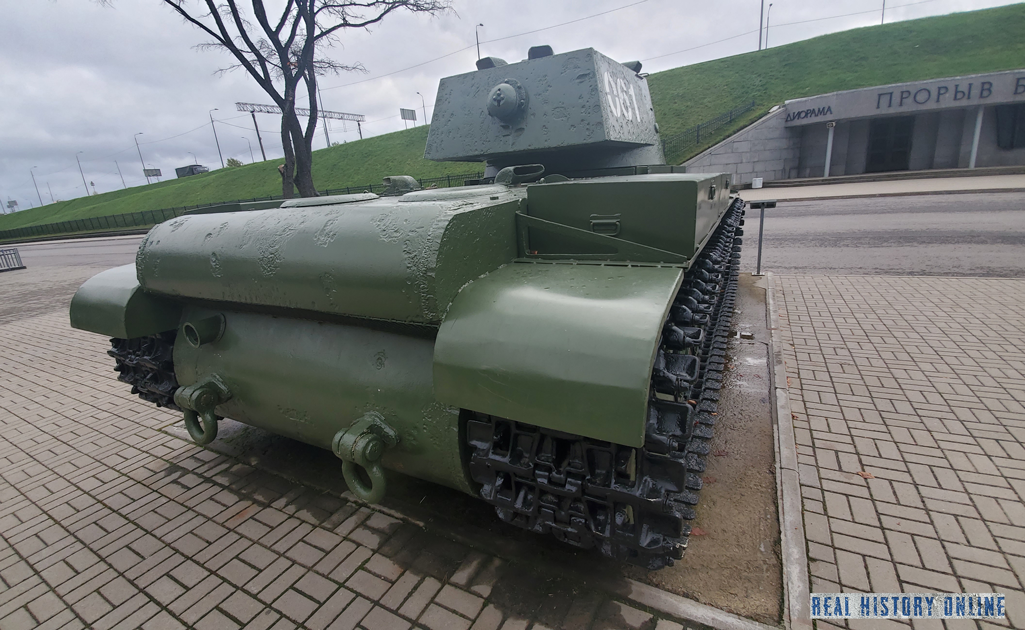
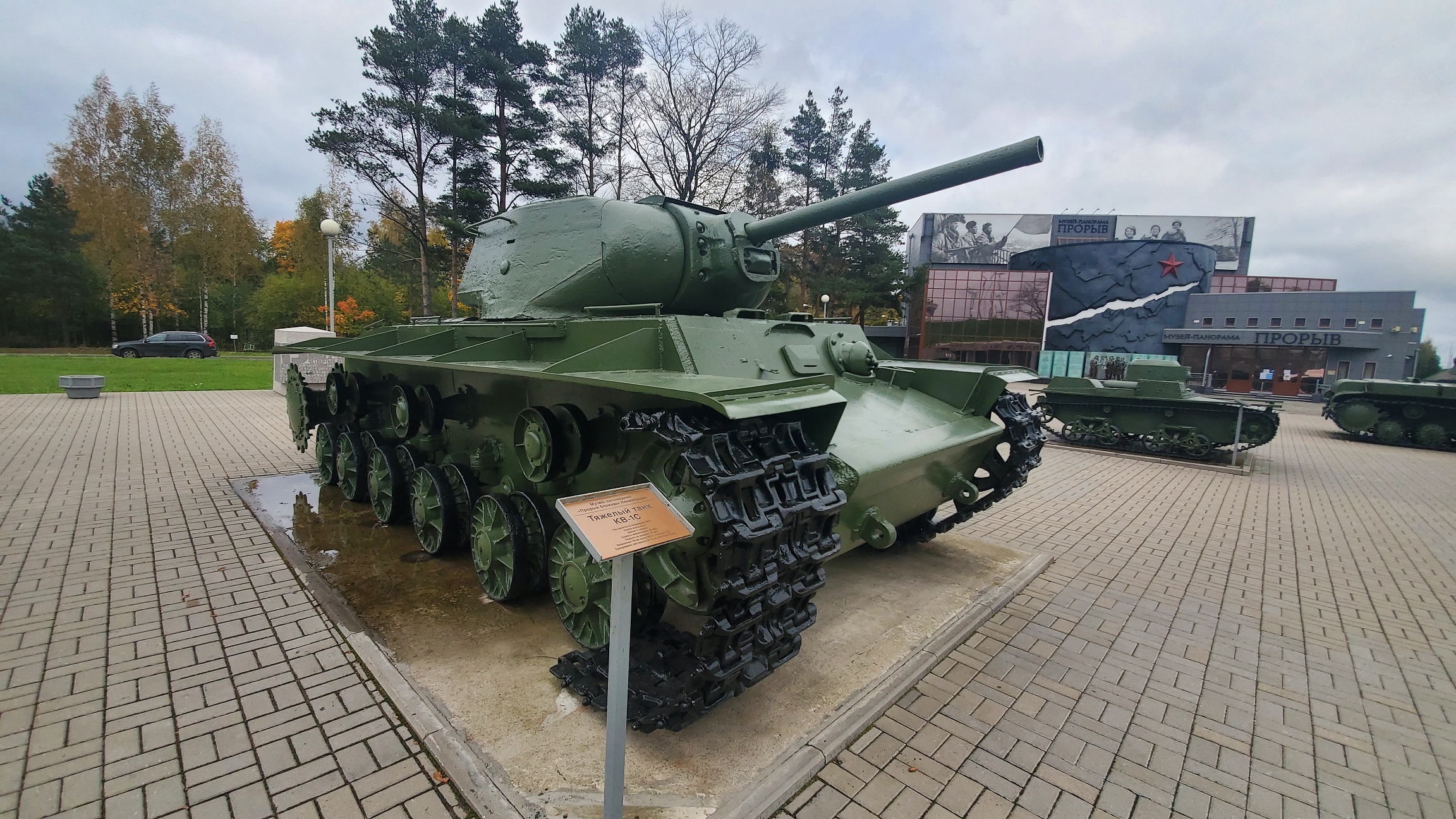
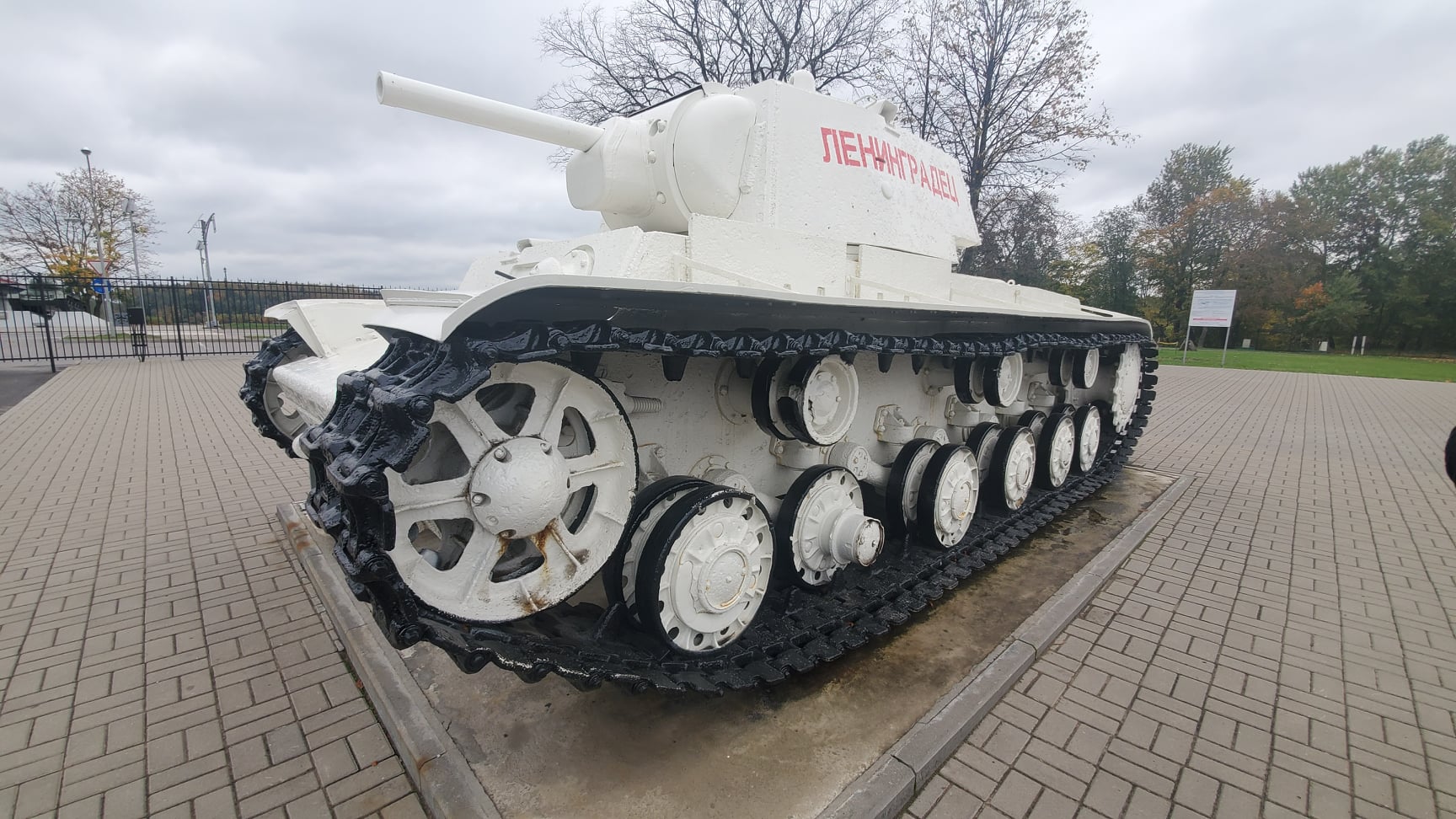
In total, to date, about 10 KV-1 tanks and a number of copies of its various modifications have been preserved in different countries of the world.
- Central Museum of the Armed Forces in Moscow – tanks KV-1 and KV-2
- Armored Museum in Kubinka (Moscow region) – an experimental tank “Object 238” (KV-85G) with an 85-mm gun.
- monuments in the village of Ropsha – KV-1
- memorial in the village Maryino (near the city of Kirovsk, Leningrad Region – Museum-Reserve “Breakthrough of the Siege of Leningrad” 2 KV-1 tanks and 1 KV-1s tank
- Parfino, Novgorod region – KV-1s (with KV-1 hull).
- St. Petersburg, near st. Avtovo metro station – KV-85 tank (further development of KV-1s)
- Exhibition complex ” Sestroretsky frontier “, the city of Sestroretsk (Korortny district of St. Petersburg) – the tower of the KV-1 tank, converted into a firing point
- Museum of Military Equipment “Battle Glory of the Urals” in Verkhnyaya Pyshma, Sverdlovsk Region – KV-1 mod. 1939 and KV-2 mod. 1940 (model with original elements)
- Parola Tank Museum in Finland – 2 KV-1s captured by Finnish troops in 1941 – a shielded tank with an F-32 cannon and a tank with a ZIS-5 cannon and a cast turret (both with Finnish markings and hakaristi).
- tank museum in Saumur France – KV-1 with F-32 gun.
- Aberdeen Proving Ground in the USA – KV-1 with a cast turret.
- Tank Museum in Bovington UK – KV-1 with a cast turret.
- Museum “Battle for Leningrad” named after Zinovy Grigorievich Kolobanov (Leningrad region, Vsevolozhsk city, Narodnaya street 5) – KV-1 No. M5200 junior lieutenant Vasily Iosifovich Lastochkin. The tank was discovered in 2011 at the bottom of the Neva in the Kirovsky district of the Leningrad region. Museum staff found that the tank sank on November 30, 1941, when a ferry was pierced at the time of evacuation for repairs from the Nevsky Piglet bridgehead. On November 16, 2011, the KV-1 was raised to the surface, and by the spring of 2015 it was restored to running condition.
During the Middle Don offensive operation “Small Saturn”, which took place in the winter of 1942, while crossing the Don River near the village of Upper Mamon, a KV tank was lost, which slipped off an improvised crossing. In the winter of 2013-2014, with the participation of Wargaming, the tank was examined in order to raise it. At the moment (June 2014), the efforts of the same company raised the hull of the tank, which was badly damaged. It is supposed to raise all parts of the tank and its further restoration.


